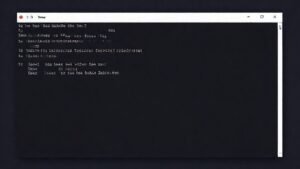SQL duplicate SubKey Guide: Detecting Duplicates in DB2
- THE MAG POST

- Aug 20
- 11 min read

SQL duplicate SubKey detection is a practical concern when maintaining data quality in relational databases. In this module we explore robust methods to surface all records that participate in a duplicates condition defined by more than one SubKey = 1 occurrence for the same GUID/ID/Key group. The conversation centers on two reliable strategies: a grouping-based approach with HAVING and a window-function approach that propagates a duplication flag across rows. By combining clarity with performance considerations, we equip you to implement dependable SQL queries that reveal full detail rows for remediation. The core idea—identify duplicates by SubKey = 1 then fetch the complete rows—will guide you through real-world data-cleaning workflows. SQL duplicate SubKey is the thread that ties these techniques together and improves your ability to diagnose and clean inconsistent data in production environments.
In this module, we explore how to identify all records where the SubKey value of 1 repeats within the same group defined by GUID, ID, and Key in a DB2-like SQL environment. We will step through concrete strategies, from straightforward grouping to robust window-function techniques, and we will illustrate how to return the full detail rows for any GUID that has more than one SubKey = 1 occurrence. The goal is to provide practical, production-friendly queries that surface duplicates while preserving all related fields for downstream analysis and cleanup. This topic centers on SQL duplicate SubKey detection and how to translate business rules into reliable SQL patterns.
Problem Setup: SQL duplicate SubKey detection
The task is to identify all records where SubKey = 1 repeats for the same logical group, defined by GUID, ID, and Key. We want the output to include every row for those groups, not just the rows with SubKey = 1. In other words, once a GUID/ID/Key combination has multiple SubKey = 1 entries, we want all details for all rows with that GUID/ID/Key to be returned. This mirrors common data-cleaning scenarios where a recurring SubKey value signals a data quality concern that warrants further inspection.
We start with a concrete data sample and a precise definition of duplicates. Consider a table with columns GUID, ID, Key, SubKey. A duplicates condition occurs when, for a given GUID/ID/Key, there are two or more rows with SubKey = 1. The desired result is the full tuples for all rows belonging to those duplicated groups, such as all rows for a GUID that has multiple SubKey = 1 records. This helps analysts understand the scope of duplicates and take corrective action consistently.
Data Snapshot
The dataset contains rows with fields GUID, ID, Key, SubKey. The goal is to surface all records for those GUIDs that exhibit more than one SubKey = 1 occurrence. Concretely, from the sample, ABC-123-DEF with ID 1234567 has SubKey = 1 for multiple rows (20 and 22), triggering a duplicates condition. The resulting output would include all rows for GUID ABC-123-DEF and ID 1234567, regardless of whether SubKey equals 1 or 2 in those rows. Recognizing these patterns helps design scalable queries for larger datasets while keeping the logic easy to audit and verify.
Definition of Duplicates
We define duplicates as any GUID/ID/Key group where the count of rows with SubKey = 1 exceeds 1. The duplicates condition is established by a grouping rule, and once identified, we return all rows that belong to those groups. This approach aligns with common data governance practices: flag the offending groups and retrieve their complete context for remediation and reporting.
In practice, the duplicates condition can be validated by running a simple aggregation that counts SubKey = 1 occurrences per group. If the count is greater than 1, the group is considered duplicated and should be included in the final result. This method is straightforward to implement and easy to extend for additional filters or business rules.
Expected Output Pattern
The expected output includes full detail rows for all entries in GUID/ID/Key groups where SubKey = 1 appears more than once. For example, if GUID=ABC-123-DEF and ID=1234567 have two SubKey = 1 occurrences (20 and 22), then all rows sharing GUID=ABC-123-DEF and ID=1234567 would be returned, including those with SubKey values other than 1 (e.g., 21 with SubKey = 2). This ensures a complete view of the duplicates and supports subsequent data-cleansing steps.
SQL duplicate SubKey Detection Strategy
This section outlines effective strategies to identify duplicates and return all related rows, focusing on two complementary approaches widely used in SQL: a grouping-based method and a window-function method. Both approaches aim to surface all records tied to duplicated groups, enabling comprehensive review and remediation while preserving full row detail for downstream processes. The emphasis is on readability, maintainability, and performance in typical DB2-like environments.
Grouping and Having Approach
The first strategy leverages a grouped subquery to locate GUIDs that have more than one SubKey = 1 occurrence, then returns all rows associated with those GUIDs. This approach is intuitive: identify duplicates by aggregation, then fetch complete records for the flagged keys. It scales well for moderate data volumes and is straightforward to audit in production environments. The core idea is to filter by GUIDs whose SubKey = 1 counts exceed one, and then join back to retrieve all details for those GUIDs.
In practice, you may implement this in two steps: (1) compute the set of duplicated GUIDs with a HAVING COUNT(*) > 1 on SubKey = 1, and (2) select all rows whose GUID is in that set. This separation helps maintain clear logic and makes it easier to enforce additional constraints, such as filtering by a date window or a specific Key value, without modifying the core duplication logic.
Window Function Approach
The second strategy uses a windowed aggregate to propagate a duplication flag to every row within each GUID group. By computing a running count of SubKey = 1 within each partition (GUID), we can filter to rows where this count exceeds one, returning every row for those duplicated groups. This method avoids a separate join and can be more efficient for large datasets. It also scales nicely when additional columns (like SubKey or date) are included in the partition or order clauses.
Window functions offer a powerful, concise way to express the duplicates rule directly in a single pass. They are particularly convenient when you need to retain the full detail set and apply more nuanced post-processing, such as ordering by SubKey, or materializing the result into a subsequent analytic step for dashboards or reports.
Implementation Details: Step-by-step SQL
Here we translate the strategies into concrete SQL that you can adapt to your DB2 environment. We show both the grouping-based approach and the window-function approach, with a focus on retrieving complete records for duplicated groups. The examples assume a table named your_table with columns GUID, ID, Key, SubKey. You can replace the table name and column list as needed. The goal is to produce a reliable, maintainable solution that surfaces all rows for GUID/ID/Key combinations with multiple SubKey = 1 entries.
Query 1: Group By with HAVING
This variant first identifies the set of GUIDs that have more than one SubKey = 1 occurrence, using a grouped subquery, and then returns all rows whose GUID appears in that set. This approach is easy to read and can be extended with additional filters. The final result includes all rows for the duplicated GUIDs, not just the duplicates themselves.
Example SQL (adjust to your schema):
SELECT GUID, ID, Key, SubKey
FROM your_table AS t
WHERE GUID IN (
SELECT GUID
FROM your_table
WHERE SubKey = 1
GROUP BY GUID
HAVING COUNT(*) > 1
)
ORDER BY GUID, ID, Key, SubKey;
In this query, we identify all GUIDs that have multiple SubKey = 1 occurrences and then fetch all corresponding rows. This aligns with the requirement to output complete details for the duplicated groups.
Query 2: Window Function
The windowed approach computes a per-row duplication flag by counting SubKey = 1 within each GUID partition, then filters to those partitions with a count greater than 1. This method yields all rows belonging to the duplicated groups in a single pass and is highly scalable for large datasets.
Example SQL (adjust to your schema):
SELECT GUID, ID, Key, SubKey
FROM (
SELECT t.*,
SUM(CASE WHEN SubKey = 1 THEN 1 ELSE 0 END) OVER (PARTITION BY GUID) AS cnt_sub1
FROM your_table t
) AS sub
WHERE cnt_sub1 > 1
ORDER BY GUID, ID, Key, SubKey;
These two approaches provide robust options for identifying and exporting duplicates based on SubKey = 1. Depending on your data volumes and DB2 version, you may prefer the explicit GROUP BY path for clarity or the window function path for potentially better performance on larger datasets.
Worked Validation and Examples
We validate the methods with representative samples, ensuring the output includes all relevant rows for duplicated groups. The validation steps cover common edge cases, such as multiple SubKey = 1 entries for the same GUID/ID/Key, mixed SubKey values within the duplicated groups, and scenarios where no duplicates exist. The goal is to confirm that the queries are resilient, reproducible, and transparent to reviewers or auditors who rely on the results for data cleansing or governance reporting.
Test Scenarios
Scenario A tests a GUID with two SubKey = 1 entries and a single SubKey = 2 entry. The expected result includes all rows with that GUID/ID/Key. Scenario B tests a GUID with only one SubKey = 1 entry, which should not appear in the final result. Scenario C includes multiple GUIDs with varying counts of SubKey = 1, ensuring the queries correctly identify and pull all rows for all duplicated groups. These scenarios help verify correctness across typical data distributions.
In practice, you can automate this validation by scripting synthetic data, running the two approaches, and comparing results to a reference implementation. This ensures consistent behavior across environments and helps catch edge cases early in the development cycle.
Illustrative Output Comparison
The following descriptive summary highlights what the final output should contain for the sample data: for GUID 'ABC-123-DEF' and ID '1234567', because there are two SubKey = 1 entries, all rows sharing that GUID/ID should be returned, including the SubKey values 1 and 2. For GUID 'ABC-124-DEF', if only one SubKey = 1 is present, those rows should not appear in the final output. This pattern helps ensure reporting and remediation align with the defined duplicates rule.
Final Solution
Consolidated Query for Duplicated Groups
To surface all records for any GUID/ID/Key group with multiple SubKey = 1 occurrences, you can combine the approaches conceptually by using the GROUP BY with HAVING to determine duplicates, then retrieving full details for the identified GUIDs. The window-function approach provides a single-pass alternative that is often preferable for large datasets. The core idea remains the same: identify duplicated groups by SubKey = 1 counts and return complete rows for those groups. The resulting dataset supports downstream cleaning, auditing, and reporting tasks with clarity and precision.
Performance Considerations
Performance depends on data size, indexing, and DB2 optimizations. An index on (GUID, ID, Key, SubKey) can speed up grouping and window operations, while filtering on SubKey = 1 before grouping can reduce data scanned in some scenarios. When data volumes are large, consider partitioning strategies or materialized views for frequently repeated checks. Always validate query plans to ensure the chosen approach aligns with your workload and DB2 version capabilities.
Similar Problems (with 1–2 line solutions)
Below are related tasks leveraging the same duplication-detection approach, each with a concise solution snippet and a brief explanation of what it achieves.
Find GUIDs with multiple SubKey = 2 occurrences
SELECT GUID FROM your_table WHERE SubKey = 2 GROUP BY GUID HAVING COUNT(*) > 1; This mirrors the idea of detecting duplicates, but focusing on SubKey = 2 to identify groups with similar repetition patterns.
This helps flag groups where a different SubKey value repeats, enabling broader data-quality checks beyond SubKey = 1.
Return only duplicated groups with SubKey = 1
SELECT GUID, ID, Key, SubKey FROM your_table t WHERE SubKey = 1 AND EXISTS (SELECT 1 FROM your_table t2 WHERE t2.GUID = t.GUID AND t2.SubKey = 1 GROUP BY t2.GUID HAVING COUNT(*) > 1); This narrows to the exact duplicates while preserving detail rows.
It demonstrates how EXISTS can be used to drive precise duplication checks with minimal data movement.
Duplicates by (GUID, Key) irrespective of ID
SELECT GUID, Key, COUNT(*) AS dup_count FROM your_table WHERE SubKey = 1 GROUP BY GUID, Key HAVING COUNT(*) > 1; This abstracts away ID to focus on the core grouping by GUID and Key to reveal duplication patterns.
It shows how alternative groupings can surface different dimensions of duplication for governance reviews.
Windowed duplicates with partition by Key
SELECT GUID, ID, Key, SubKey FROM (SELECT t.*, SUM(CASE WHEN SubKey = 1 THEN 1 ELSE 0 END) OVER (PARTITION BY GUID, Key) AS cnt FROM your_table t) s WHERE cnt > 1; This variant aggregates duplicates across a broader partition, useful when Key is a strong grouping dimension.
It demonstrates flexibility in windowing to tailor the duplication search to business rules that emphasize Key as a primary grouping factor.
Count-based duplicates with a date filter
SELECT GUID, ID, Key, SubKey FROM your_table t WHERE SubKey = 1 AND t.event_date >= DATE '2024-01-01' GROUP BY GUID, ID, Key, SubKey HAVING COUNT(*) > 1; This adds a time constraint to the duplicates check for temporal data quality tracking.
It highlights how time-bound analyses can inform periodic cleansing workflows and trend analyses.
Parameterized duplicates for staging environments
SELECT GUID, ID, Key, SubKey FROM staging_table t JOIN (SELECT GUID FROM staging_table WHERE SubKey = 1 GROUP BY GUID HAVING COUNT(*) > 1) s ON t.GUID = s.GUID; Useful for validating duplicates in non-production environments before production data maturation.
It underscores best practices for safe testing and gradual data-cleaning rollouts.
Additional Code Illustrations (Related to the Main Program)
These focused SQL snippets extend the main approach and demonstrate practical variants for real-world data workflows.
SQL: Find duplicates with a status flag
SELECT GUID, ID, Key, SubKey, status
FROM your_table
WHERE GUID IN (
SELECT GUID
FROM your_table
WHERE SubKey = 1
GROUP BY GUID
HAVING COUNT(*) > 1
)
ORDER BY GUID, ID, Key, SubKey;
This variant adds a status flag to the final result, enabling downstream filtering or routing based on workflow status while preserving the duplication logic.
SQL: Windowed duplicates with additional partitioning
SELECT GUID, ID, Key, SubKey, status
FROM (
SELECT t.*,
SUM(CASE WHEN SubKey = 1 THEN 1 ELSE 0 END) OVER (PARTITION BY GUID, Key) AS cnt_sub1
FROM your_table t
) AS w
WHERE cnt_sub1 > 1
ORDER BY GUID, Key, ID, SubKey;
This variation demonstrates how expanding the partition by (adding Key as a partition) can adapt the duplication check to more granular business rules while keeping all rows intact for review.
SQL: Pre-aggregated results sent to reporting layer
SELECT r.GUID, r.ID, r.Key, r.SubKey, agg.dup_count
FROM your_table r
JOIN (
SELECT GUID, COUNT(*) AS dup_count
FROM your_table
WHERE SubKey = 1
GROUP BY GUID
HAVING COUNT(*) > 1
) AS agg ON r.GUID = agg.GUID
ORDER BY r.GUID, r.ID, r.Key, r.SubKey;
This pattern pre-aggregates duplicates and then joins to surface complete rows, optimized for downstream reporting dashboards where duplication details are needed alongside performance metrics.
SQL: Subset of duplicates with a date window
SELECT GUID, ID, Key, SubKey, event_date
FROM (
SELECT t.*, SUM(CASE WHEN SubKey = 1 THEN 1 ELSE 0 END) OVER (PARTITION BY GUID) AS cnt_sub1
FROM your_table t
) AS q
WHERE cnt_sub1 > 1 AND event_date >= DATE '2024-01-01'
ORDER BY GUID, event_date;
This illustrates how to combine duplicates logic with a temporal constraint, supporting time-bounded data-cleaning campaigns and historical analyses.
SQL: Dual-condition duplication with Key emphasis
SELECT GUID, ID, Key, SubKey
FROM your_table
WHERE GUID IN (
SELECT GUID
FROM your_table
WHERE SubKey = 1
GROUP BY GUID, Key
HAVING COUNT(*) > 1
)
ORDER BY GUID, Key, ID, SubKey;
This variant emphasizes duplication detection when the Key dimension is a critical grouping factor, enabling targeted cleansing by Key while retaining full records for review.
Aspect | Details |
Topic | SQL duplicate SubKey detection |
Approach A | GROUP BY with HAVING |
Approach B | WINDOW functions (SUM OVER) |
Output | Full rows for duplicated GUID/ID/Key groups |
DB2 Compatibility | Works with standard SQL; adjust syntax for older DB2 versions |






















































Comments